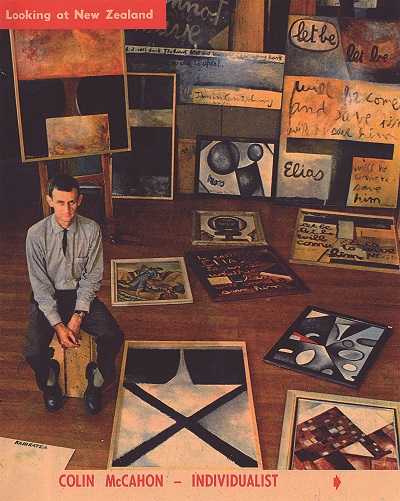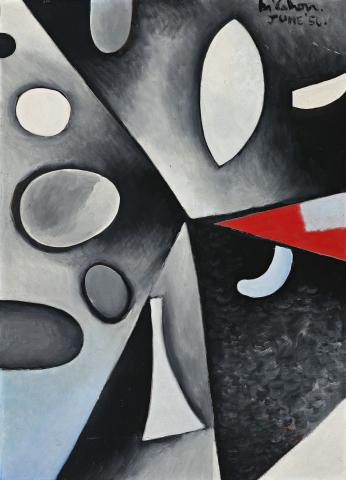PAINTING, 1956
COLIN McCAHON
oil on cardboard
76.0 x 55.0 cm
signed and dated upper right: McCahon. / June ’56.
inscribed verso in pencil: 58 Shelly Beach Rd
inscribed verso in brushpoint: Colin McCahon / Art Gallery / Auckland / Painting June ‘ 56 / oil / N.F.S. / Insurance 20 gns
Harrods, London, abandoned storage auction
Private collection, Queensland, acquired from the above c.1980
Possibly: The Group Show, 1956, The Art Gallery Durham Street, Christchurch, New Zealand, 3 November – 18 November 1956, cat. 98 (nfs) or 102 (nfs)
dh1530 NZ Woman's Weekly_Pcmyk.jpg

The recent discovery and identification of this painting adds another unique and challenging ‘abstract’ work from 1956 to Colin McCahon’s incredible achievement. Generally regarded as a ‘blank’ year in the artist’s career where drawing dominated, and a year given little attention from curators and writers, perhaps 1956 represented a critical point of change and cross-roads for the artist.
Later recalling his art from 1956 and 1957 McCahon said ‘I see I was right now in thinking the previous year [1956] as one of little painting and lots of drawing. I came to grips with the kauri and turned him in all his splendour into a symbol.’1
By early 1954, McCahon, then living in Auckland, had become a permanent member of the staff at the Auckland City Art Gallery, involved in curating exhibitions, writing catalogues and teaching. In September 1954 he was involved in curating Object and Image, an exhibition of non-representational painting which included his abstracted Kauri paintings.
In 1954 McCahon produced his first ‘word’ paintings which were to culminate in the Elias series of 1959. In another direction, he was sourcing the reduced shapes for his Gate series to follow in the early 1960s, the First Bellini Madonna painting and references to Mondrian. Yet the consistent and more even backdrop at this time comprised the semi-abstracted, faceted ‘cubist’ landscapes of Titirangi and French Bay and the Kauri subjects. Assured and powerful in their own right these led towards minimal abstraction.
Painting, 1956 belongs to a small group of abstract compositions painted that year. Related works, Composition from April 1956, Moss from May 1956, [Abstract] from August – September 1956, and other French Bay and Kauri subjects from this year, were all painted on the same sized cardboard supports. The deciphering of Painting, 1956 with its floating shapes, strong linear divisions and flash of red is not straight forward. The artist is pushing firmly in a new direction.
‘When Colin abstracts, he leaves a sense of the things he has decided to disregard. They make their absence felt. He is not interested in doing things with shapes, colours and textures simply for their own sakes’.2
1. McCahon quoted in Colin McCahon / a survey exhibition, Auckland City Art Gallery, Auckland, 1972, exhibition catalogue, p. 24
2. Introduction by R. N. O’Reilly in Colin McCahon / a survey exhibition, Auckland City Art Gallery, Auckland, 1972, exhibition catalogue, pp. 13 – 14
CHRIS DEUTSCHER
